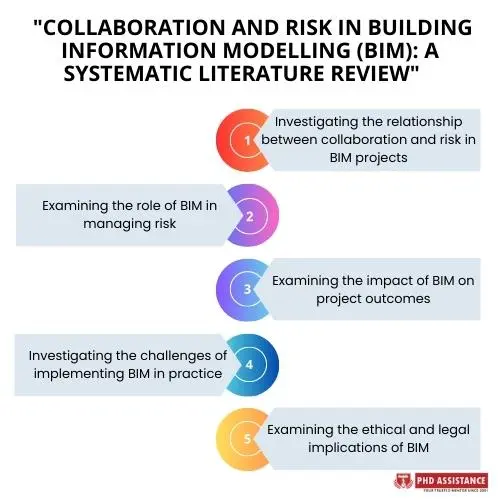Future research areas in the paper collaboration and risk in BIM
What are the recommendations for future research areas in the paper “Collaboration and Risk in Building Information Modelling (BIM): A Systematic Literature Review.”
Building information modelling (BIM) has become increasingly popular in construction projects in recent years. Simultaneously, project management has received more attention from academics and practitioners worldwide. Many studies have suggested that perceiving collaboration and risk is critical for successful construction project management. This blog provides several recommendations for future research in building information modelling (BIM) literature review examples for research proposals from the Web of Science database. This review systematically uses bibliometric and systematic literature review (SLR) methods through co-occurrence and co-citation analysis.
Introduction
What exactly is BIM research?
Building Information Modeling (BIM) has brought about significant advances in architecture, engineering, and construction (AEC) as a data tool relevant to engineering design, construction, and research management. It may be used to precisely digitalize features of action research the virtual model of a building, commonly known as BIM.
The paper “Collaboration and Risk in Building Information Modelling (BIM):A Systematic Literature Review” provides several recommendations for future research.Some of these recommendations for steps in writing a research paper> include:

- Investigating the relationship between collaboration and risk in BIM projects: Future research could investigate the relationship between collaboration and risk in BIM projects in greater detail, exploring how different types of collaboration (e.g., between designers, contractors, and owners) methodology in research proposal could impact the overall risk of the project.
- Examining the role of BIM in managing risk: Future PhD research proposals could also examine the specific ways in which BIM can be used to manage risk in construction projects. This could involve investigating how BIM can be used to identify and mitigate risks and support effective decision-making in complex project environments.
- Examining the impact of BIM on project outcomes: Future research could also investigate the impact of BIM on project outcomes, such as project schedule, cost, and quality, in the ethical issues of the dissertation proposal. This could involve comparing BIM-enabled projects with traditional construction projects and exploring the factors contributing to BIM projects’ success.
- Investigating the challenges of implementing BIM in practice: Future research could also investigate the challenges of implementing BIM in practice, including the barriers to adoption and the factors contributing to successful implementation. This could help to identify strategies for overcoming these challenges and promoting wider adoption of BIM in the construction industry.
- Examining the ethical and legal implications of BIM: Finally, future research could examine the ethical and legal implications of BIM, particularly in relation to data privacy, intellectual property, and liability issues. This could help to inform the development of appropriate policies and regulations to govern the use of BIM in construction projects.
Overall, these recommendations highlight the need for further research to understand better the complex relationships between collaboration, risk, and BIM in construction projects. By addressing these research designs and gaps, scholars can help to inform the development of more effective BIM-enabled project management strategies and promote the wider adoption of BIM in the construction industry.
Conclusion
This article suggests a method for performing a topical literature reviewfor Building Information Modeling (BIM). It contains academic papers, as well as frequently used keywords, prolific authors, prominent journal sources, and current research themes in the BIM literature. Collaboration in BIM, integration of BIM, GIS, and IoT, hurdles to BIM integration, sustainability and BIM, and risk assessment and uncertainty are some of the notable study themes in the BIM literature. The review’s findings have theoretical and practical implications for both scholars and practitioners. The study restricts the scope of the analyzed BIM literature to academic documents obtained from the Web of Science database. It would be interesting to conduct a similar analysis with a larger spectrum in future studies.
Check our study guide to know more about “How to Write Research Proposal for PhD Dissertation”.
PhD Assistance
Ph.D. Assistance’s expert team comprises devoted researchers who will go with you, think from your experience, and discover potential research gaps for your PhD research project. We ensure that you have a thorough grasp of the background and past research conducted by other researchers, which will assist academics in identifying a research topic and providing resources for constructing a compelling argument with their supervisor.
References
Ali, K.N.; Alhajlah, H.H.; Kassem, M.A. Collaboration and Risk in Building Information Modelling (BIM): A Systematic Literature Review. Buildings 2022, 12, 571.



